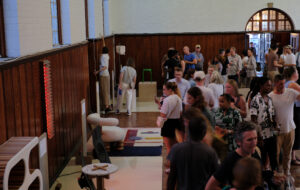|
|
||
|
A vintage image of the Starship Enterprise enigmatically graces the poster advertising Alternative Histories, an exhibition chronicling the experimental, independent and activist art spaces in New York City since the 1960s. A pop icon, the starship carries with it the original Star Trek title narration, which haunts our collective cultural imagination with the phrase: “To boldly go where no man has gone before.” As installed in Exit Art’s gallery on the west side of Manhattan, the art show has little to do with the television show, but hung in the gallery, the Starship Enterprise, boldly floating in space, represents a pioneering mission and, perhaps, an unexpected case of boomer nostalgia. Curators Papo Colo and Jeanette Ingberman (with Herb Tam and Lauren Rosati) include 130 alternative art spaces and projects in the exhibition. A long table runs dramatically down the centre of Exit Art’s black-curtained main space. Cardboard archival boxes, each stencilled with the name of an art space, are stacked alphabetically. Visitors are invited to put on white cotton gloves and pick gingerly through the materials: catalogues, little magazines, photographs and press releases. This is the archive as performance. The names inscribed on the boxes are both familiar and vague recollections. They remind us that cultural hotshots like PS1, The New Museum of Contemporary Art and Creative Time, institutions that loom large on New York City’s art scene, started out as upstarts. When the New Museum opened in 1977 it took an oppositional stance and, according to founder Marcia Tucker in a snippet of wall text, “[Threw] a grenade into the idea of exhibitions.” Others encapsulated a period of New York lore and then shut their doors as the city changed around them. Like FOOD, the artist-run restaurant founded by Carol Gooden on the suggestion of Gordon Matta-Clark in 1971, which served up an experimental menu to the arty SoHo community until it closed in the early 80s. Or Gas Station (1982-1997), a defunct service station-cum-scrap metal sculpture garden where Vito Acconci and Allen Ginsberg (two names that liberally pepper the gallery) performed poetry, which was denied landmark status and overrun by condo development. Because Alternative Histories is unwittingly an exhibition about real estate, it’s surprising not to see the various spaces mapped. It would reveal a decade-by-decade dissipation of arts organisations out of Lower Manhattan into the boroughs — first Williamsburg, then Greenpoint, Bushwick, Bed-Stuy and Downtown Brooklyn. More inclined toward social history than data mapping, the curators include a number of podcast interviews and archival videos. “History” in the title Alternative Histories dominates the show. It takes two large side galleries to display a timeline from 1960 to the present. A piece of archival ephemera and a short narrative accompanies each entry, such as a page of browning newsprint with an image of Federal Plaza and the words After Tilted Arc: The Aesthetic Quest and Public Life — the catalogue for a 1985 show at Storefront for Art and Architecture. The choice of that particular Storefront exhibition, which brought together critics and artists to address the heated debate around the sculpture, a kind of rapid response not taken up as often these days, reveals Exit Art’s curatorial focus on a lost activism once inherent in the programming of alternative spaces. In 2010, contemporary discourse shies away from such controversy. Alternative Histories may be preoccupied with the past, but does send an important message to young and contemporary organisations (such as Brooklyn’s scrappy Superfront or cerebral Cabinet magazine) that the role of the alternative space is political. Or, as curator Papo Colo closes his introductory text: “Alter your life and the world will change.” It’s a statement as idealistic as an episode of Star Trek, but Exit Art presents a history to back it up. Alternative Histories. Exit Art. Until November 24, 2010. |
Image Alternative Histories
Words Mimi Zeiger |
|
|
||
















